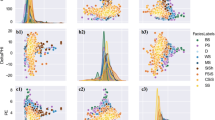Abstract
Making full use of the remaining oil-gas resources is a practical and feasible way to solve the problem of oil shortage. And the most important step of this method is the accurate detection of stratigraphic interface. In this paper, we propose a Convolutional Neural Network (CNN) approach for stratigraphic interface detection from the geophysical well logging data. Our proposed approach can automatically extract representative features from well logs data. It can reduce errors caused by human factors such as manual randomness and lack of experience. First of all, we normalize the data in the form of a single point of the well logging data and convert data points to 2D segment. We then feed segments into the CNN model for training. Secondly, we predict the formation of the well logging data using the trained model. Finally, we introduce a post-processing method to perform the stratigraphic interface detection. The experimental results demonstrate the proposed approach is able to achieve \(89.69\%\) of the average accuracy of stratigraphic interface detection. Moreover, the relative error between the predicted boundary points with the ground-truth is only \(1\%\), which indicates the proposed approach satisfy the real-world application requirements.
This work was supported in part by the National Key R&D Program of China (No. 2018AAA0102801 and No. 2018AAA0102803), in part of the National Natural Science Foundation of China (No. 61772424, No. 61702418, and No. 61602383), and in part by 13th Five-Year Plan of China National Petroleum Corporation Limited (2019A-3610).
Access this chapter
Tax calculation will be finalised at checkout
Purchases are for personal use only
Similar content being viewed by others
References
Lecun, Y., Bengio, Y., Hinton, G.: Deep learning. Nature 521(7553), 436 (2015)
Zhou, C., Ouyang, J., Ming, W., et al.: A stratigraphic prediction method based on machine learning. Appl. Sci. 9(17), 3553 (2019)
He, M., Gu, H., Wan, H.: Log interpretation for lithology and fluid identification using deep neural network combined with MAHAKIL in a tight sandstone reservoir. J. Pet. Sci. Eng. 194, 107498 (2020)
Qiao, J., Pan, M., Li, Z., et al.: 3D Geological modeling from DEM, boreholes, cross-sections and geological maps (2011)
Caumon, G., Mallet, J.: 3D Stratigraphic models: representation and stochastic modelling (2018)
Hawkins, D.M., Merriam, D.F.: Optimal zonation of digitized sequential data. Math. Geol. 5, 389–395 (1973)
Hawkins, D.M., Merriam, D.F.: Zonation of multivariate sequences of digitized geologic data. Math. Geol. 6, 263–269 (1974)
McIntyre, R.M., Blashfield, R.K.: A nearest-centroid technique for evaluating the minimum-variance clustering procedure. Multivar. Behav. Res. 15(2), 225–238 (1980)
Hathaway, R.J., Bezdek, J.C.: Local convergence of the fuzzy c-Means algorithms. Pattern Recogn. 19(6), 477–480 (1986)
Shahab, M.: Virtual-intelligence applications in petroleum engineering: part 1-artificial neural networks. J. Petrol. Technol. 52(9), 64–73 (2000)
Hecht-Nielsen, R.: Theory of the backpropagation neural network. Neural Netw. (1988)
Rumelhart, D.E., Hinton, G.E., Williams, R.J.: Learning representations by back propagating errors. Nature 323(6088), 533–536 (1986)
Hubek, D., Wiesel, T.: Receptive fields, binocular interaction and functional architecture in the cat’s visual cortex. J. Physiol. 160, 106–154 (1962)
Le, Q.V., Jaitly, N., Hinton, G.E.: A simple way to initialize recurrent networks of rectified linear units. Comput. Sci. (2015)
Glorot, X., Bordes, A., Bengio, Y.: Deep sparse rectifier neural networks. J. Mach. Learn. Res. 15, 315–323 (2011)
Srivastava, N., Hinton, G., Krizhevsky, A., et al.: Dropout: a simple way to prevent neural networks from overfitting. J. Mach. Learn. Res. 15(1), 1929–1958 (2014)
Kingma, D.P., Ba, J.: Adam: a method for stochastic optimization. Comput. Sci. (2014)
Duchi, J., Hazan, E., Singer, Y.: Adaptive subgradient methods for online learning and stochastic optimization. J. Mach. Learn. Res. 12(7), 257–269 (2011)
Chiou-Jye, H., Ping-Huan, K.: A deep CNN-LSTM model for particulate matter (PM2.5) forecasting in smart cities. Sensors 18(7), 2220 (2018)
Xin-Hu, L.I.: Study on well logging curve shape automatic identification method. Pet. Geol. Oilfield Dev. Daqing (2006)
Dharmawardhana, H.P.K., Keller, G.V.: Statistical method for the determination of zone boundaries using well log data. In: SPE Annual Technical Conference and Exhibition. Society of Petroleum Engineers (1985)
Kerzner, M.G.: An analytical approach to detailed dip determination using frequency analysis. In: SPWLA 23rd Annual Logging Symposium. Society of Petrophysicists and Well-Log Analysts (1982)
Kerzner, M.G., Frost Jr., E.: Blocking-a new technique for well log interpretation. J. Petrol. Technol. 36(02), 267–275 (1984)
Lanning, E.N., Johnson, D.M.: Automated identification of rock boundaries: an application of the Walsh transform to geophysical well-log analysis. Geophysics 48(2), 197–205 (1983)
Maiti, S., Tiwari, R.K.: Automatic detection of lithologic boundaries using the Walsh transform: a case study from the KTB borehole. Comput. Geosci. 31(8), 949–955 (2005)
Pan, S.Y., Hsieh, B.Z., Lu, M.T., et al.: Identification of stratigraphic formation interfaces using wavelet and Fourier transforms. Comput. Geosci. 34(1), 77–92 (2008)
Wu, X., Nyland, E.: Automated stratigraphic interpretation of well-log data. Geophysics 52(12), 1665–1676 (1987)
Author information
Authors and Affiliations
Corresponding author
Editor information
Editors and Affiliations
Rights and permissions
Copyright information
© 2021 ICST Institute for Computer Sciences, Social Informatics and Telecommunications Engineering
About this paper
Cite this paper
Zhang, J., Li, G., Zhang, J., Zhang, G., Zhou, W. (2021). A Convolutional Neural Network Approach for Stratigraphic Interface Detection. In: Li, B., Li, C., Yang, M., Yan, Z., Zheng, J. (eds) IoT as a Service. IoTaaS 2020. Lecture Notes of the Institute for Computer Sciences, Social Informatics and Telecommunications Engineering, vol 346. Springer, Cham. https://doi.org/10.1007/978-3-030-67514-1_42
Download citation
DOI: https://doi.org/10.1007/978-3-030-67514-1_42
Published:
Publisher Name: Springer, Cham
Print ISBN: 978-3-030-67513-4
Online ISBN: 978-3-030-67514-1
eBook Packages: Computer ScienceComputer Science (R0)




